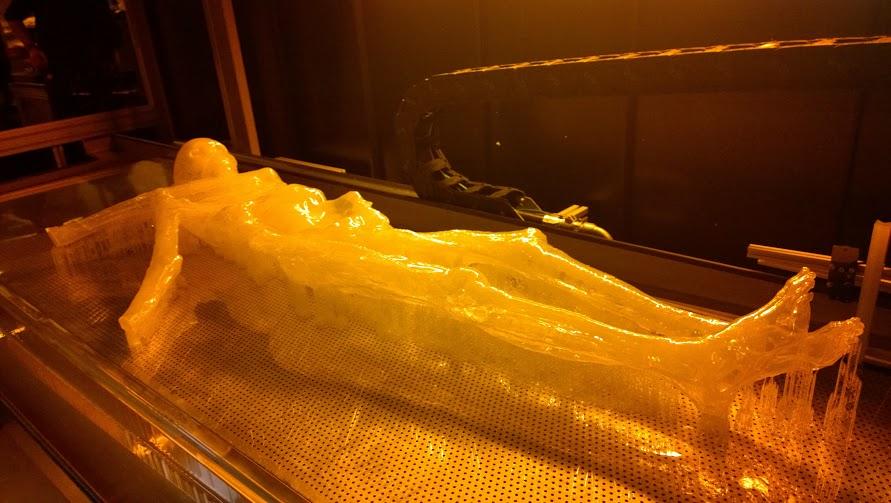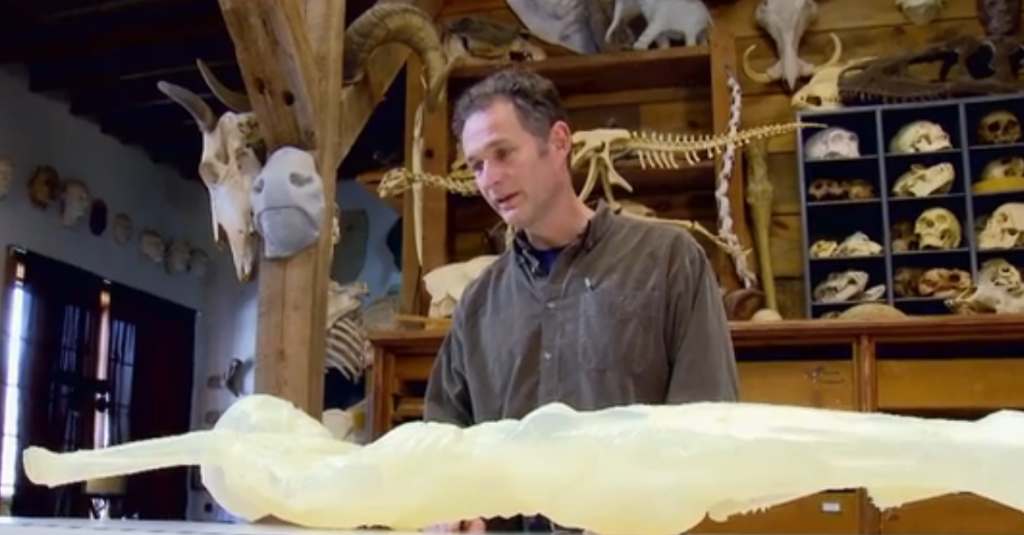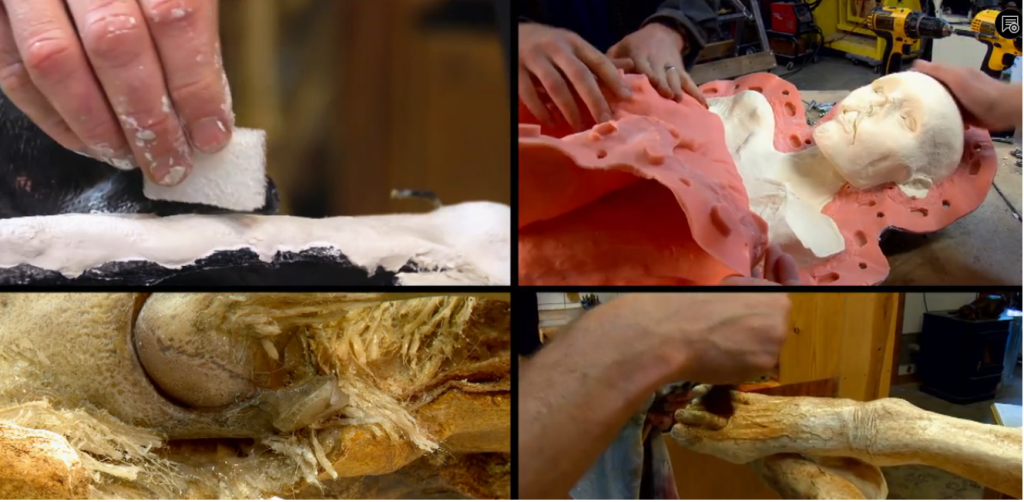Reborn in the Amber Resin of the 3D Printer: Nova Documentary Shows Ötzi the Ice Man’s Twin Being Created by Paleo Artist & Materialise Team
 They say the truth always comes out—eventually. But five thousand years later? As a murder occurred 5,300 years ago on a freezing and lonely Tyrolean Alpine peak in what is now North Italy, the perpetrator probably certainly never imagined his victim would be discovered by an entirely new culture centuries later who would be very, very curious. Not only that, but in the discovery of his deathly repose, he became quite famous; in fact, Ötzi the Ice Man has been the center of fascination for many years—most especially by scientists—since he was discovered in 1991 by hikers, face down and entombed in ice, along with a bevy of tools and his ancient, but well-preserved, belongings.
They say the truth always comes out—eventually. But five thousand years later? As a murder occurred 5,300 years ago on a freezing and lonely Tyrolean Alpine peak in what is now North Italy, the perpetrator probably certainly never imagined his victim would be discovered by an entirely new culture centuries later who would be very, very curious. Not only that, but in the discovery of his deathly repose, he became quite famous; in fact, Ötzi the Ice Man has been the center of fascination for many years—most especially by scientists—since he was discovered in 1991 by hikers, face down and entombed in ice, along with a bevy of tools and his ancient, but well-preserved, belongings.
In the decades since he was found, the fascination with the Ice Man has just continued to grow on the part of researchers and doctors. And he presents us, quite literally, with a body of information that seems to grow and grow as technology progresses and allows us to dig deeper for clues to who Ötzi was and how he may have lived, and died. Now, thanks to a another collaboration between world-famous paleo artist Gary Staab and the world-renowned 3D printing experts at Materialise (led by Brian Crutchfield, Managing Director of Materialise, USA), science and art merged into one as 3D printing has been used to bring us an incredible replica of Ötzi the Ice Man. Meanwhile, the real mummy remains protected in a climate-controlled vault at the South Tyrol Museum of Archaeology in Italy where he has earned the title as one of the most studied humans of all time.
 Staab and his team were actually granted 30 mintues of nerve-wracking access to the lab and then the frozen lair of the mummy, marking the beginning of the challenging process to make a ‘twin’ via 3D printing. A documentary of the entire process was brought to the public to see on Nova, in a February 17th episode called ‘Iceman Reborn.’
Staab and his team were actually granted 30 mintues of nerve-wracking access to the lab and then the frozen lair of the mummy, marking the beginning of the challenging process to make a ‘twin’ via 3D printing. A documentary of the entire process was brought to the public to see on Nova, in a February 17th episode called ‘Iceman Reborn.’
In watching the footage, it’s plain to see that while Staab is getting digital images of the mummy, he is also memorizing every detail possible with his own eyes. While it’s certainly rare to have this sort of experience, both Staab and the Materialise team also previously had the privilege—and complex task–of making a 3D replica of the famous Egyptian pharaoh Tutankhamun.
A major scientific project has been in progress since 1991, as experts of all sorts are studying the man who died at 45, stood about five-foot-two, and had brown eyes. Scientists even know that he had Lyme disease and perhaps the beginnings of heart disease as well. Not only that—there was an arrowhead lodged in his shoulder, and it was one that delivered a fatal blow from an unknown murderer stalking him on the mountaintop. This of course, raised multitudinous questions about the fragile skeleton kept at 19 degrees in the sterile Italian lab. While Staab and the Materialise team certainly had their work cut out for them, because there was already such a substantial amount of CT scans taken of Ötzi, they were able to use many of them in his re-creation.
For fabrication of the replica, indeed the Materialise team used over 2,000 digital ‘slices’ to make a 3D print, but there were—not surprisingly—many challenges for the artists, engineers, and scientists involved. The Iceman was missing some body parts, so those had to be recreated; for example, some of his ribs had to be redesigned, and they were able to do this with 3D scans of his existing ribs. Once everything was able to be spliced into one continuous image, they were able to work on one continuous 3D print.
If you’ve done any 3D printing, and thought it took a little while for your piece to finish—imagine waiting a full three days. That’s how long it took for Ötzi to be reborn as Materialise employed their enormous SLA 3D printer, allowing The Iceman to emerge from a vat of amber resin—and standing 5’5” tall.“Materialise process-segmented all of the scan data, made a fantastic accurate print, and I was able to add the details over the top of the print to turn it into an accurate, life-like replica of the original,” said Staab. “It was another fantastic 3D collaboration with Materialise and its team of engineers.”
After the application of paint to the 3D print, Staab began the intricate process of making the finishing touches which would allow Ötzi to become incredibly life-life, and nearly identical to the real mummy locked away in his contemporary freezing tomb.
It bears taking a moment to soak in the gravity of what 3D printing has been able to do in showing us the intricate details of this ancient man—and not only that, it’s deeply fascinating to see how technology that still seems as if it belongs in the future has come to bring us in touch with the deep, deep past via an ancestor of the European Bronze Age.“There’s not one centimeter of this thing that isn’t complicated,” stated Staab as he began working on the 3D print, which required months of work to achieve the desired effect—involving sculpting, molding, painting, and crafting.
“It is going to be very hard,” he said surveying the print further, embarking on matching skin, color, texture—and even replicating the mummy’s very large collection of bodily tattoos. Ötzi has 61 tattoos, actually, of all which have been catalogued, and are a study of their own as there is no other mummy in existence with so many tattoos.
“We are proud that our 3D medical modeling technology could make a contribution to a greater understanding of the Iceman and his times,” said Brian Crutchfield, Managing Director of Materialise, USA. “That our medical printing technology is so advanced yet flexible enough to be adapted to such important scientific and historic study is truly reflective of our team’s emphasis on research and value for its healthcare customers.”
Once Staab had finished his painstaking work, he invited Albert Zink, PhD, Head of the Institute for Mummies and the Iceman, to come and take a look at the finished product. It was quite an emotional scene, with a very nervous Staab showing off his work and Zink’s reaction, which was one of nearly speechless awe. Seeing the 3D print in process from beginning to the end, and in quite a momentous evaluation, is a wonderful journey, and we highly recommend you view the show if you didn’t see it when it aired. As the experts point out, who knows, this famous Ice Man could actually be one of your very distant relatives! Discuss this amazing process in the 3D Printed Ice Man forum over at 3DPB.com.
Subscribe to Our Email Newsletter
Stay up-to-date on all the latest news from the 3D printing industry and receive information and offers from third party vendors.
You May Also Like
Precision at the Microscale: UK Researchers Advance Medical Devices with BMF’s 3D Printing Tech
University of Nottingham researchers are using Boston Micro Fabrication‘s (BMF) 3D printing technology to develop medical devices that improve compatibility with human tissue. Funded by a UK grant, this project...
3D Printing Webinar and Event Roundup: April 21, 2024
It’s another busy week of webinars and events, starting with Hannover Messe in Germany and continuing with Metalcasting Congress, Chinaplas, TechBlick’s Innovation Festival, and more. Stratasys continues its advanced training...
3D Printing Webinar and Event Roundup: March 17, 2024
It’s another busy week of webinars and events, including SALMED 2024 and AM Forum in Berlin. Stratasys continues its in-person training and is offering two webinars, ASTM is holding a...
3D Printed Micro Antenna is 15% Smaller and 6X Lighter
Horizon Microtechnologies has achieved success in creating a high-frequency D-Band horn antenna through micro 3D printing. However, this achievement did not rely solely on 3D printing; it involved a combination...

































